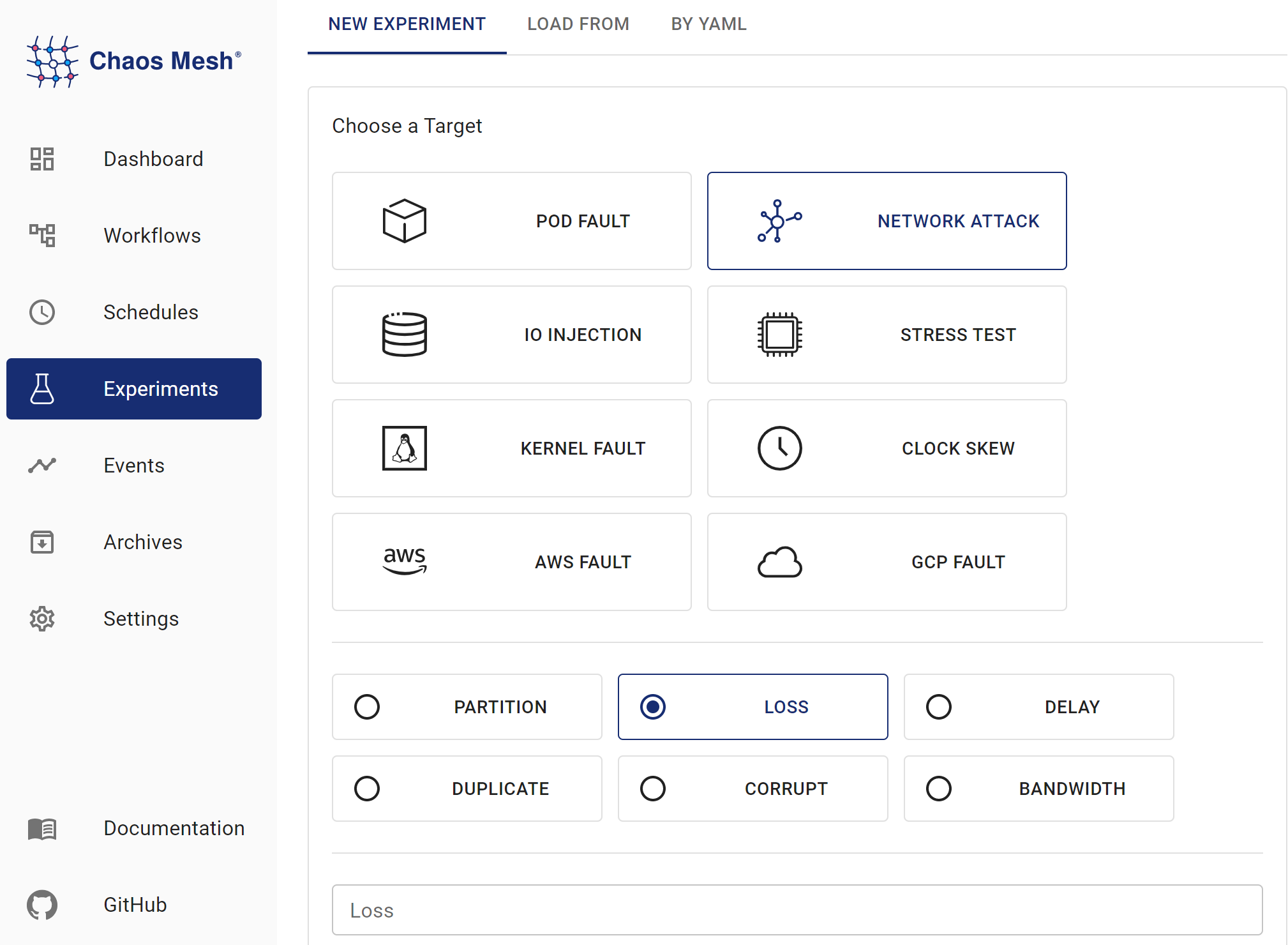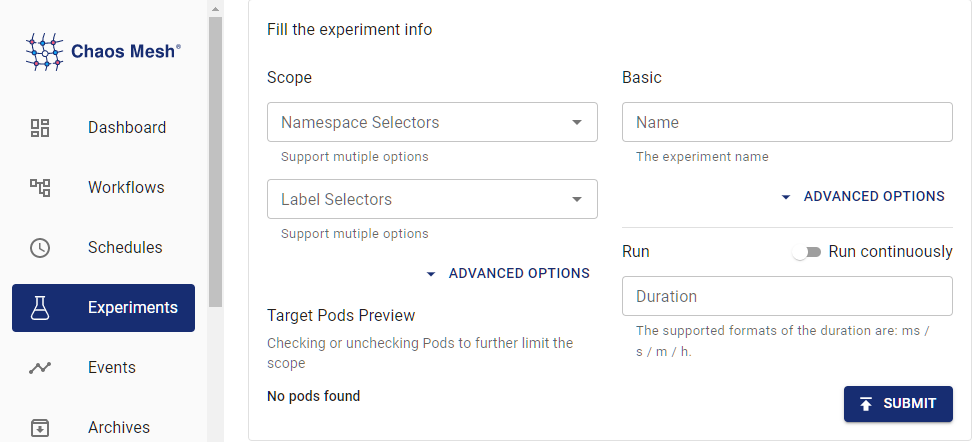Simulate Network Faults
This document describes how to simulate network faults using NetworkChaos in Chaos Mesh.
NetworkChaos introduction
NetworkChaos is a fault type in Chaos Mesh. By creating a NetworkChaos experiment, you can simulate a network fault scenario for a cluster. Currently, NetworkChaos supports the following fault types:
- Partition: network disconnection and partition.
- Net Emulation: poor network conditions, such as high delays, high packet loss rate, packet reordering, and so on.
- Bandwidth: limit the communication bandwidth between nodes.
Notes
Before creating NetworkChaos experiments, ensure the following:
- During the network injection process, make sure that the connection between Controller Manager and Chaos Daemon works, otherwise the NetworkChaos cannot be restored anymore.
- If you want to simulate Net Emulation fault, make sure the NET_SCH_NETEM module is installed in the Linux kernel. If you are using CentOS, you can install the module through the kernel-modules-extra package. Most other Linux distributions have installed the module already by default.
Create experiments using Chaos Dashboard
Open Chaos Dashboard, and click NEW EXPERIMENT on the page to create a new experiment:

In the Choose a Target area, choose NETWORK ATTACK and select a specific behavior, such as LOSS. Then fill out specific configuration.

For details of specific configuration fields, refer to Field description.
Fill out the experiment information, and specify the experiment scope and the scheduled experiment duration.

Submit the experiment information.
Create experiments using the YAML files
Net emulation example
Write the experiment configuration to the
network-delay.yamlfile, as shown below:apiVersion: chaos-mesh.org/v1alpha1
kind: NetworkChaos
metadata:
name: delay
spec:
action: delay
mode: one
selector:
namespaces:
- default
labelSelectors:
'app': 'web-show'
delay:
latency: '10ms'
correlation: '100'
jitter: '0ms'This configuration causes a latency of 10 milliseconds in the network connections of the target Pods. In addition to latency injection, Chaos Mesh supports packet loss and packet reordering injection. For details, see field description.
After the configuration file is prepared, use
kubectlto create an experiment:kubectl apply -f ./network-delay.yaml
Partition example
Write the experiment configuration to the
network-partition.yamlfile, as shown below:apiVersion: chaos-mesh.org/v1alpha1
kind: NetworkChaos
metadata:
name: partition
spec:
action: partition
mode: all
selector:
namespaces:
- default
labelSelectors:
'app': 'app1'
direction: to
target:
mode: all
selector:
namespaces:
- default
labelSelectors:
'app': 'app2'This configuration blocks the connection created from
app1toapp2. The value for thedirectionfield can beto,fromorboth. For details, refer to Field description.After the configuration file is prepared, use
kubectlto create the experiment:kubectl apply -f ./network-partition.yaml
Bandwidth example
Write the experiment configuration to the
network-bandwidth.yamlfile, as shown below:apiVersion: chaos-mesh.org/v1alpha1
kind: NetworkChaos
metadata:
name: bandwidth
spec:
action: bandwidth
mode: all
selector:
namespaces:
- default
labelSelectors:
'app': 'app1'
bandwidth:
rate: '1mbps'
limit: 20971520
buffer: 10000This configuration limits the bandwidth of
app1to 1 mbps.After the configuration file is prepared, use
kubectlto create the experiment:kubectl apply -f ./network-bandwidth.yaml
Field description
| Parameter | Type | Description | Default value | Required | Example |
|---|---|---|---|---|---|
| action | string | Indicates the specific fault type. Available types include: netem, delay (network delay), loss (packet loss), duplicate (packet duplicating), corrupt (packet corrupt), partition (network partition), and bandwidth (network bandwidth limit).After you specify action field, refer to Description for action-related fields for other necessary field configuration. | None | Yes | Partition |
| target | Selector | Used in combination with direction, making Chaos only effective for some packets. | None | No | |
| direction | enum | Indicates the direction of target packets. Available values include from (the packets from target), to (the packets to target), and both ( the packets from or to target). This parameter makes Chaos only take effect for a specific direction of packets. | to | No | both |
| mode | string | Specifies the mode of the experiment. The mode options include one (selecting a random Pod), all (selecting all eligible Pods), fixed (selecting a specified number of eligible Pods), fixed-percent (selecting a specified percentage of Pods from the eligible Pods), and random-max-percent (selecting the maximum percentage of Pods from the eligible Pods). | None | Yes | one |
| value | string | Provides a parameter for the mode configuration, depending on mode. For example, when mode is set to fixed-percent, value specifies the percentage of Pods. | None | No | 1 |
| selector | struct | Specifies the target Pod. For details, refer to Define the experiment scope. | None | Yes | |
| externalTargets | []string | Indicates the network targets except for Kubernetes, which can be IPv4 addresses or domains. This parameter only works with direction: to. | None | No | 1.1.1.1, www.google.com |
| device | string | Specifies the affected network interface | None | No | "eth0" |
Description for action-related fields
For the Net Emulation and Bandwidth fault types, you can further configure the action related parameters according to the following description.
- Net Emulation type:
delay,loss,duplicated,corrupt - Bandwidth type:
bandwidth
delay
Setting action to delay means simulating network delay fault. You can also configure the following parameters.
| Parameter | Type | Description | Required | Required | Example |
|---|---|---|---|---|---|
| latency | string | Indicates the network latency | No | No | 2ms |
| correlation | string | Indicates the correlation between the current latency and the previous one. Range of value: [0, 100] | No | No | 50 |
| jitter | string | Indicates the range of the network latency | No | No | 1ms |
| reorder | Reorder(#Reorder) | Indicates the status of network packet reordering | No |
The computational model for correlation is as follows:
Generate a random number whose distribution is related to the previous value:
rnd = value * (1-corr) + last_rnd * corrrndis the random number.corris thecorrelationyou fill out before.Use this random number to determine the delay of the current packet:
((rnd % (2 * sigma)) + mu) - sigmaIn the above command,
sigmaisjitterandmuislatency.
reorder
Setting action to reorder means simulating network packet reordering fault. You can also configure the following parameters.
| Parameter | Type | Description | Default value | Required | Example |
|---|---|---|---|---|---|
| reorder | string | Indicates the probability to reorder. Range of value: [0, 100] | 0 | No | 50 |
| correlation | string | Indicates the correlation between this time's length of delay time and the previous time's length of delay time. Range of value: [0, 100] | 0 | No | 50 |
| gap | int | Indicates the gap before and after packet reordering | 0 | No | 5 |
loss
Setting action to loss means simulating packet loss fault. You can also configure the following parameters.
| Parameter | Type | Description | Default value | Required | Example |
|---|---|---|---|---|---|
| loss | string | Indicates the probability of packet loss. Range of value: [0, 100] | 0 | No | 50 |
| correlation | string | Indicates the correlation between the probability of current packet loss and the previous time's packet loss. Range of value: [0, 100] | 0 | No | 50 |
duplicate
Set action to duplicate, meaning simulating package duplication. At this point, you can also set the following parameters.
| Parameter | Type | Description | Default value | Required | Example |
|---|---|---|---|---|---|
| duplicate | string | Indicates the probability of packet duplicating. Range of value: [0, 100] | 0 | No | 50 |
| correlation | string | Indicates the correlation between the probability of current packet duplicating and the previous time's packet duplicating. Range of value: [0, 100] | 0 | No | 50 |
corrupt
Setting action to corrupt means simulating package corruption fault. You can also configure the following parameters.
| Parameter | Type | Description | Default value | Required | Example |
|---|---|---|---|---|---|
| corrupt | string | Indicates the probability of packet corruption. Range of value: [0, 100] | 0 | No | 50 |
| correlation | string | Indicates the correlation between the probability of current packet corruption and the previous time's packet corruption. Range of value: [0, 100] | 0 | No | 50 |
For occasional events such as reorder, loss, duplicate, and corrupt, the correlation is more complicated. For specific model description, refer to NetemCLG.
bandwidth
Setting action to bandwidth means simulating bandwidth limit fault. You also need to configure the following parameters.
| Parameter | Type | Description | Default value | Required | Example |
|---|---|---|---|---|---|
| rate | string | Indicates the rate of bandwidth limit | Yes | 1mbps | |
| limit | string | Indicates the number of bytes waiting in queue | Yes | 1 | |
| buffer | uint32 | Indicates the maximum number of bytes that can be sent instantaneously | Yes | 1 | |
| peakrate | uint64 | Indicates the maximum consumption of bucket (usually not set) | No | 1 | |
| minburst | uint32 | Indicates the size of peakrate bucket (usually not set) | No | 1 |
For more details of these fields, you can refer to tc-tbf document. The limit is suggested to set to at least 2 * rate * latency, where the latency is the estimated latency between source and target, and it can be estimated through ping command. Too small limit can cause high loss rate and impact the throughput of the tcp connection.